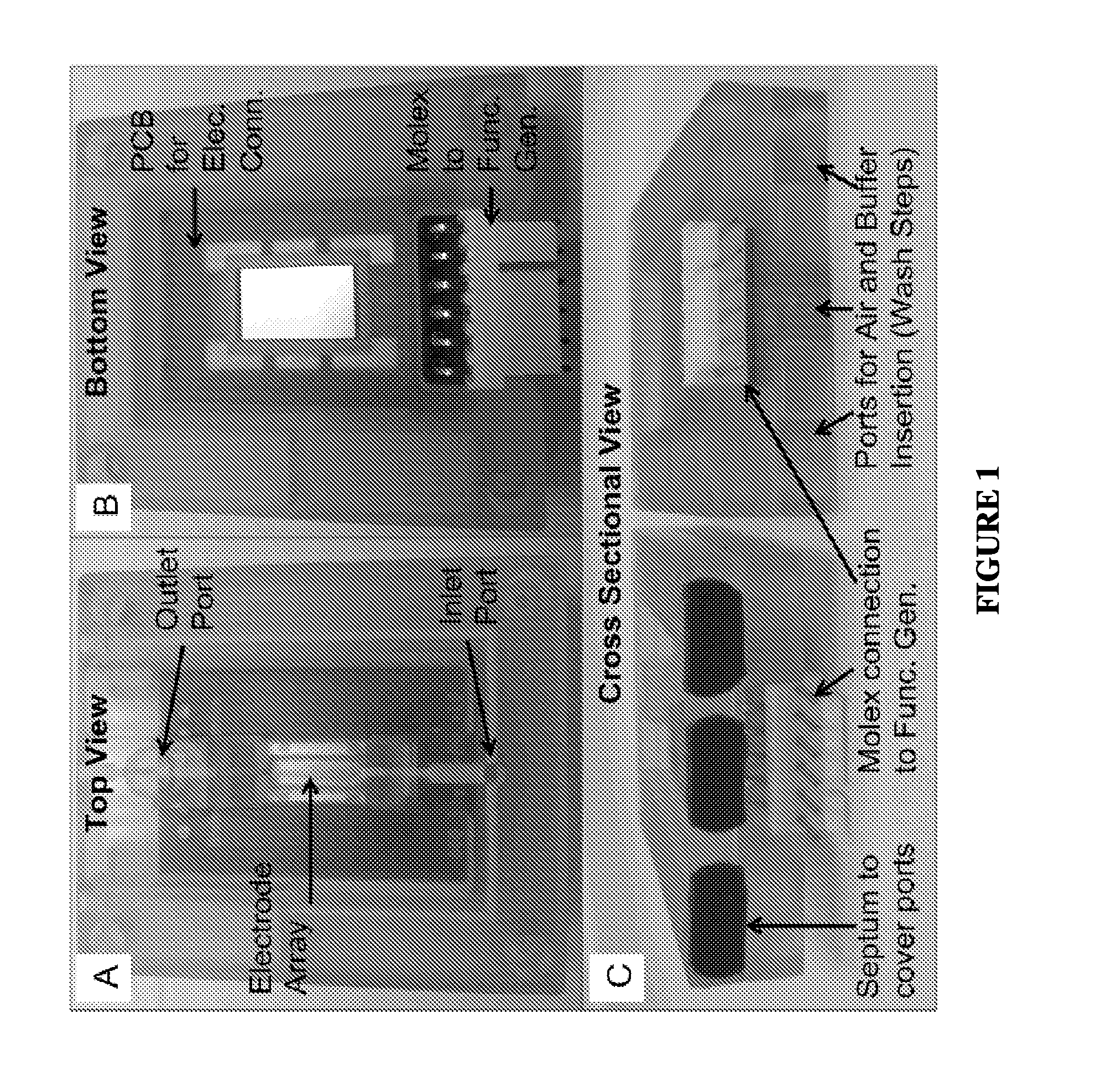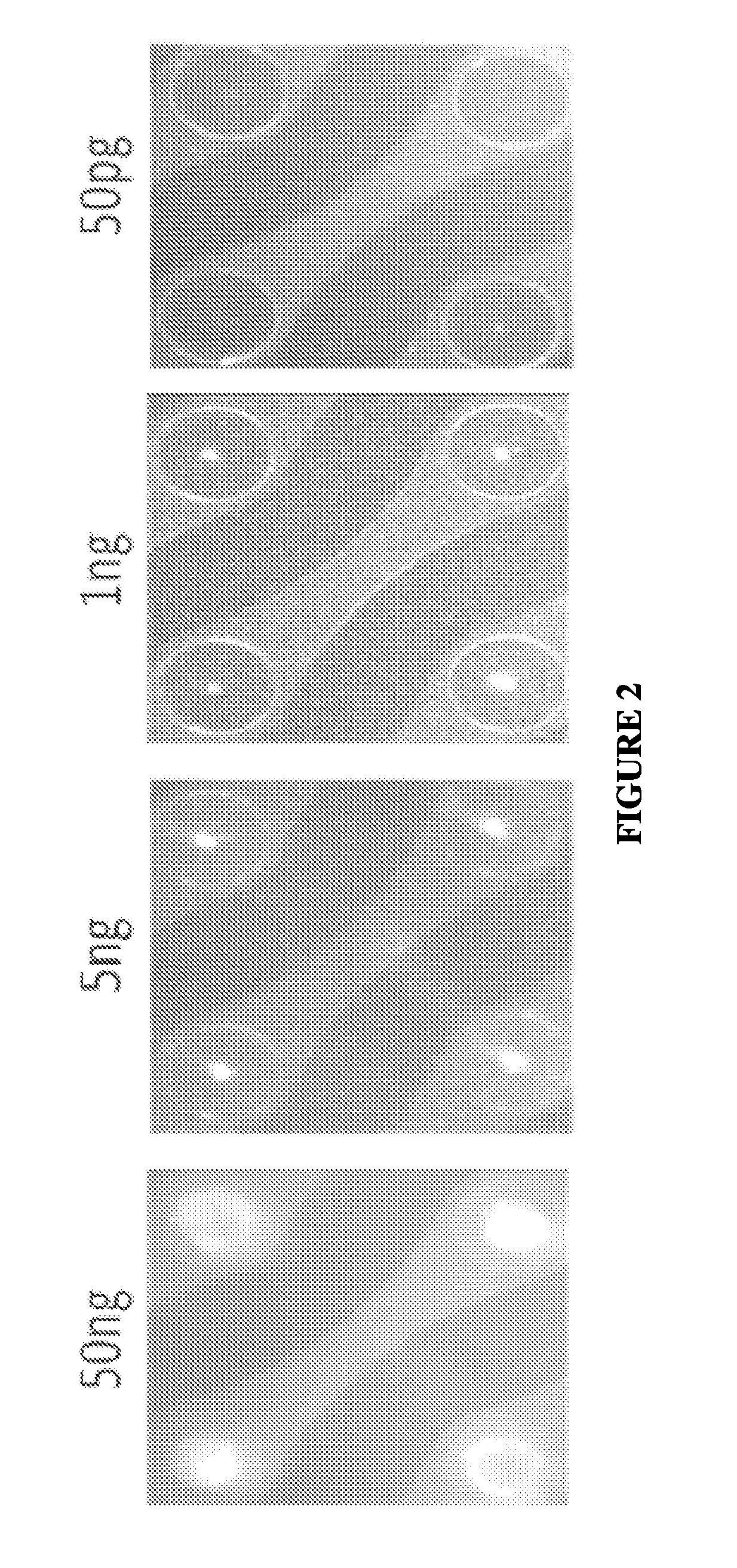Nucleic acid sample preparation
a technology of nucleic acid and sample preparation, which is applied in the direction of fluid pressure measurement, liquid/fluent solid measurement, peptide measurement, etc., can solve the problems of inability to meet the needs of sequencing and inability to isolate dna suitable for sequencing, and achieve high-purification nucleic acids, facilitate multiplexing and high-throughput operation
- Summary
- Abstract
- Description
- Claims
- Application Information
AI Technical Summary
Benefits of technology
Problems solved by technology
Method used
Image
Examples
example 1
Formation of Hydrogel by Spin-Coating (Two Coats) 1
[0200]For a layer of hydrogel, approximately 70 microliters of hydrogel is used to coat a 10×12 mm chip.
[0201]A low concentration (≦1% solids by volume) cellulose acetate solution is dissolved into a solvent such as acetone, or an acetone and ethanol mixture and applied to an electrode array chip as disclosed herein. The chip is spun at a low rpm rate (1000-3000). The low rpm rate ensures that the height of the gel is in the range of 500 nm or greater.
[0202]The first (bottom) coating of cellulose acetate is dried at room temperature, in a convection oven, or a vacuum oven. Optionally, the second layer of cellulose-acetate spin-coat is added immediately.
[0203]The second layer of cellulose acetate comprises a high concentration (≧2%) of cellulose acetate dissolved into a solvent such as acetone, or an acetone and ethanol mixture. After a second layer of cellulose acetate is added, the chip is spun at a high rpm rate (9000-12000). The ...
example 2
Formation of Hydrogel with Additives by Spin-Coating (Two Coats)
[0205]For a layer of hydrogel, approximately 70 microliters of hydrogel is used to coat a 10×12 mm chip.
[0206]A low concentration (≦1% solids by volume) cellulose acetate solution is dissolved into a solvent such as acetone, or an acetone and ethanol mixture and applied to an electrode array chip as disclosed herein. The chip is spun at a low rpm rate (1000-3000). The low rpm rate ensures that the height of the gel is in the range of 500 nm or greater.
[0207]The first (bottom) coating of cellulose acetate is dried at room temperature, in a convection oven, or a vacuum oven. Optionally, the second layer of cellulose-acetate spin-coat is added immediately.
[0208]The second layer of cellulose acetate comprises a high concentration (≧2%) of cellulose acetate dissolved into a solvent such as acetone, or an acetone and ethanol mixture. A low concentration (1-15%) of conductive polymer (PEDOT:PSS or similar) is added into the se...
example 3
Formation of Hydrogel with Additives by Spin-Coating (Three Coats)
[0210]For a layer of hydrogel, approximately 70 microliters of hydrogel is used to coat a 10×12 mm chip.
[0211]A low concentration (≦1% solids by volume) cellulose acetate solution is dissolved into a solvent such as acetone, or an acetone and ethanol mixture and applied to an electrode array chip as disclosed herein. The chip is spun at a high rpm rate (9000-12000). The low rpm rate ensures that the height of the gel is in the range of 300 nm or less.
[0212]The first (bottom) coating of cellulose acetate is dried at room temperature, in a convection oven, or a vacuum oven. Optionally, the second layer of cellulose-acetate spin-coat is added immediately.
[0213]The second layer of cellulose acetate comprises a high concentration (≧2%) of cellulose acetate dissolved into a solvent such as acetone, or an acetone and ethanol mixture. A low concentration (1-15%) of conductive polymer (PEDOT:PSS or similar) is added into the s...
PUM
 Login to View More
Login to View More Abstract
Description
Claims
Application Information
 Login to View More
Login to View More - R&D
- Intellectual Property
- Life Sciences
- Materials
- Tech Scout
- Unparalleled Data Quality
- Higher Quality Content
- 60% Fewer Hallucinations
Browse by: Latest US Patents, China's latest patents, Technical Efficacy Thesaurus, Application Domain, Technology Topic, Popular Technical Reports.
© 2025 PatSnap. All rights reserved.Legal|Privacy policy|Modern Slavery Act Transparency Statement|Sitemap|About US| Contact US: help@patsnap.com



